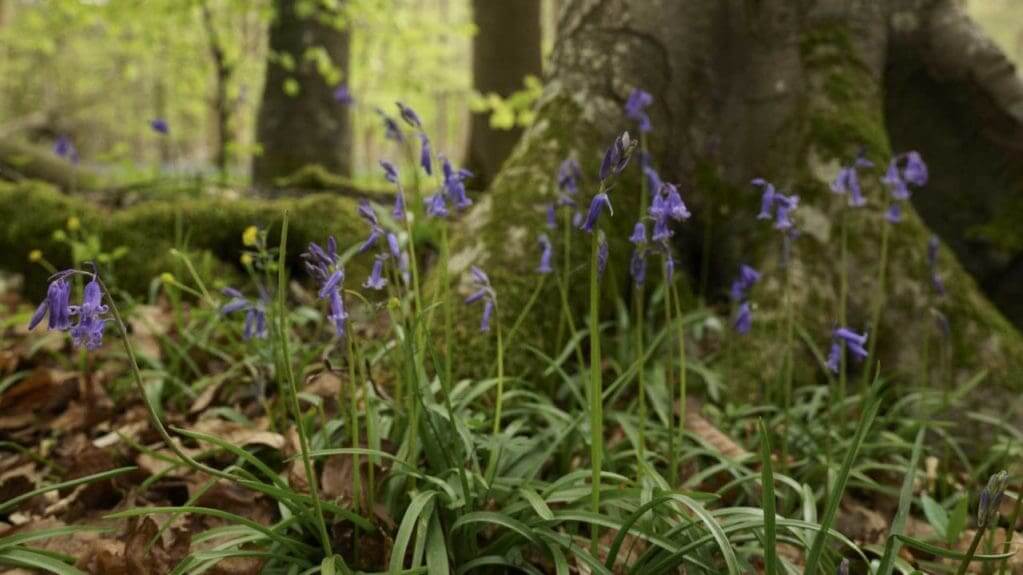Many photographers ask how to photograph bluebells but it’s actually pretty straightforward, just follow our simple guide:
How to photograph bluebells: timing
Generally, bluebells emerge in woodlands in the UK from around mid-April to mid-May but it can vary from year to year and by location. This year they seem a little late in some parts of the UK, but they are getting towards their full display in sunny locations.
The best course of action is to keep an eye on the woods near you and look out for the lush green leaves that resemble thick grass and cover the ground from early spring before the trees are in leaf. The flowers emerge as tight green buds that grow and slowly open to reveal their blue blooms.
Bright overcast conditions or weak sunshine are usually the best for photographing bluebells because the dappled light adds interest, bringing the woodland floor to life. Strong sunshine on the other hand often results in very harsh contrast, but it can look great filtering through early morning mist, creating shafts of light.
If you can cope with the early start, shooting at dawn can result in stunning images of bluebell woods.
How to photograph bluebells: Shooting position
While a woodland can seem carpeted with blue from a distance, the coverage can look rather patchy when you get closer or shoot from head height. Do not be tempted to walk amongst the bluebells, instead, stick to the path and search for a good vantage point.
Adopting a low position, narrows the gaps between the blooms, enhancing the coverage.
How to photograph bluebells: Lens selection
A telephoto lens with an effective focal length range of 70-200mm is often a good choice as it allows you to shoot distant flowers where the gaps between them seem compressed.
It also enables you to pick out individual blooms and blur the background to a soft wash of blue and green by shooting with a wide aperture.
A macro lens is also useful for getting close-up shots of details while a wide-angle lens can produce some interesting images when you go in close to a big clump of bluebells with the rest of the woodland beyond.
How to photograph bluebells: Composition
All the usual guides for composition apply when you’re shooting bluebells so bear in mind the rule of thirds and look for leading lines such as footpaths or tracks through the trees to lead your eyes into the shot.
It can be hard to find a viewpoint where the bluebells dominate when they are surrounded by huge trees, but walk around looking for the best location and use the tree trunks to give a sense of scale and distance.
A bluebell wood can make an excellent location for a portrait shoot and including a few people walking along a woodland path can also enhance a standard bluebell landscape shoot, adding scale and focus.
Photographing people in bluebells
Bluebells are extremely fragile and they’re protected under the Wildlife and Countryside Act (1981). They don’t stand up to be being trampled or laid on, so it’s important to avoid damaging them during your photography.
Take care to not stand or lie on any bluebell plants when you’re composing your images, and be vigilant about where you position the feet of your tripod.
Also, never pose models amongst bluebells. With careful choice of lens and shooting angle, it’s possible to photograph people and pets so it looks like they are surrounded by bluebells when they are actually in a clearing or on a footpath. An 85mm portrait lens or a 70-200mm lens can work very well.
If you want to add a little sparkle to your model’s eyes, or fill in the shadows on their face, use a flashgun, ideally off-camera. If you use a coloured gel, you can even replicate the golden hour using flash.
How to photograph bluebells: Exposure
Aim to keep your camera’s sensitivity setting down so ensure you capture the highest level of detail. Aperture priority or manual exposure mode are usually the best choices.
A narrow aperture such as f/16 is a good choice when you want to capture a large scene, but consider wider apertures when you’re shooting isolated flowers or clumps as this can really bring them out from the background.
As a rule, the Daylight or Sunny Weather white balance setting produces the best results, but shoot raw files to give you the maximum amount of colour data for post-capture processing.





I didn’t realize that bluebells are protected flowers, which makes them even more interesting flowers to photograph. Gorgeous shots, I think in this instance, I can just live vicariously through your images.